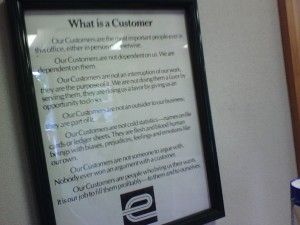September 11th, 2014 by Elma Jane
Online retailers are finding the bricks-and-clicks strategy to be an effective way to serve and engage shoppers. Perhaps that is why an increasing number of ecommerce merchants are setting up shop offline. It’s important to note, however, that a bricks-and-clicks business isn’t just about having a physical store and an ecommerce site. For this model to be effective, each channel must complement and add value to the other.
Guidelines to execute a bricks-and-clicks strategy:
Allow Access to Online Account Information in Physical Store
Bridge the gap between bricks and clicks by giving your customers and physical-store staff access to online account information. Doing so can enhance shopping experiences and drive sales.
Integrate Online and Offline Inventory, Fulfillment
Offer click-and-collect services that allow shoppers to buy merchandise online and pick it up at a local retail branch or service station. Many consumers would rather forgo the shipping costs and wait time and instead pick up their items at a time and place that’s convenient for them. Also, use your brick-and-mortar inventory when an item is out of stock online.
Use Online Data for Offline Selling, and Vice Versa
Data pertaining to online sales and traffic won’t just help you optimize your ecommerce site. It can also apply to offline decisions. For instance, if you see an increase in sales for a particular product on your website, you should consider promoting it offline, as well, to your brick-and-mortar shoppers.
Also pay attention to social media data such as Facebook likes and Pinterest pins. What’s trending on social sites can help with merchandising and marketing. Consider something similar in your brick-and-mortar business. Take note of the most liked, viewed, and pinned items online and then leverage that information when making decisions regarding product displays, inventory and more.
You can also use offline information to enhance your ecommerce site. Utilize in-store analytics tools, such as people counters and sensors, to better understand how your offline customers behave and then compare that with online behavioral data to spot patterns and opportunities.
Qualitative information, such as shoppers’ common questions and concerns, can also be used to improve your online shop. For instance, if your physical store associates keep getting the same questions about a particular product, there’s a good chance that online shoppers have similar queries. So you may want to include the answer in that item’s product description page.
Use Smartphone Beacons in Physical Stores
Beacons are Bluetooth-enabled devices that let brick-and-mortar merchants send customized offers and recommendations to their shoppers via their smartphones based on where the shoppers are in the store. For example, if a shopper is in the footwear department, the retailer can use its store beacons to send the shopper a coupon for shoes. Bricks-and-clicks businesses can also use the technology to send tailored offers to shoppers based on their online behavior.
Posted in Best Practices for Merchants Tagged with: account, Beacons, bluetooth, brick and mortar, business, consumers, coupon, customers, data, devices, ecommerce, Facebook, inventory, marketing, merchandising, Merchant's, Online Account Information, Online Data, pinterest, product, sales, shoppers, site, smartphone, social sites, store, website
May 16th, 2014 by Elma Jane
As much as you’d like to hope that no one will ever be unhappy with your product or service, you’re almost guaranteed to encounter at least a few customers who are less than fully satisfied. Where there are customers, there are complaints.
As consumers increasingly air their grievances about brands on social media, the focus has turned to the way those brands respond to customer complaints, especially in a public forum. Knowing what to do in this situation makes all the difference when it comes to re-earning a customer’s business and what he or she tells others about your company.
Great service is about getting your customers to trust you and count on a consistent experience, but that doesn’t mean you’re always going to be perfect. In a crisis, you can elevate your stature with how well you handle the situation. A negative experience can be the best time to show your value.
Great service has to come from the top. Lower level employees aren’t going to be inspired and motivated unless they see their leader providing exceptional service.
No matter which person on your team is responsible for handling customer relations, it’s imperative that you embody excellent service as the head of the company as well.
If faced with negative customer experience follow these steps to resolve the issue and regain customer’s trust.
Acknowledging the problem – Customer is always right classic customer service cliché. While it may in fact, turn out to be a misunderstanding, the worst thing you can do is dismiss a customer who tells you he or she had a problem with your business.
Apologizing for it – Once you’ve acknowledged the customer’s issue, apologize for it and ask what you can do to help. Gather the facts about the situation and determine a course of action from there.
Taking action – Saying you’re going to fix a problem is one thing, actually doing it is another. Make sure you honor your commitment to take care of the customer’s complaint. If you can’t correct the problem, offer a coupon or voucher as a way to ask the customer for another chance.
Follow up – When you’ve done what you promised to do, follow up with the customer to make sure that your solution was satisfactory.
Posted in Best Practices for Merchants, nationaltransaction.com Tagged with: brands, consumers, coupon, customer relations, customers, forum, product, public forum, service, social media, value, voucher

